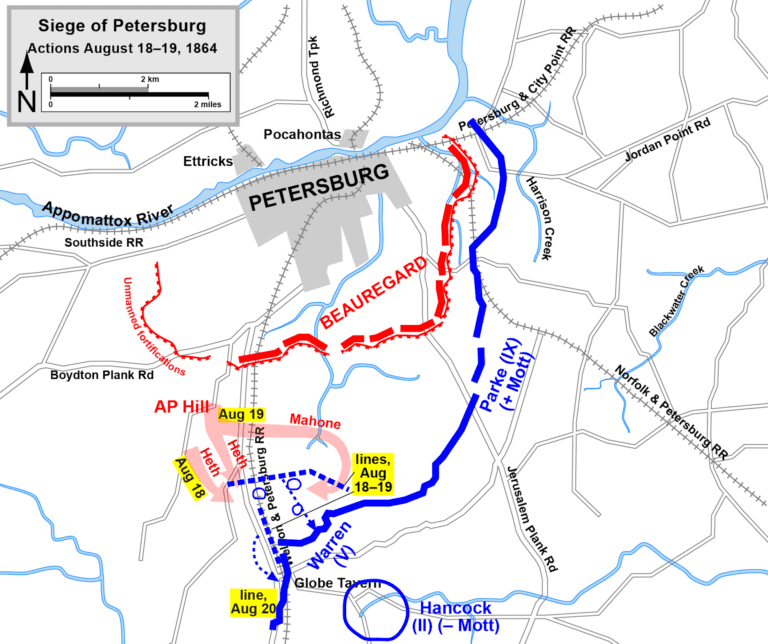The Petersburg Campaign or Siege of Petersburg took place from June 9, 1864 – March 25, 1865. For nearly 10 months a series of battles were fought where extensive trench systems were used and the largest concentration of U.S. African American troops saw action.
Today, the preserved battlefield area is in and around the Petersburg area along a 27-mile line. The Petersburg National Military Park is the epicenter. Hundreds of acres of the battlefield have been preserved by the American Battlefield Trust. Notable sites include the Crater and City Point.
Gen. Ulysses S. Grant’s Overland Campaign was a series of inconclusive battles fought against Gen. Robert E. Lee from the Rapidan to the James River in May and June 1864. After the bloody battle of Cold Harbor; May 31 – June 12, 1864, Gen. Grant moved around Gen. Lee to the south, crossed the James River, and moved to Petersburg below Richmond.
Petersburg was a vital rail junction where five railroads converged. Gen. Grant knew that if Petersburg fell, Richmond, the Confederate capital, would fall close behind. The first trenches around Petersburg were constructed in 1862 with further improvements made in the following years with redoubts, gun emplacements, moats, earthen walls, forts, and miles of earthworks.
The battle of Petersburg began on June 15, 1864, when Gen. William F. Smith moved his force against Gen. Beauregard’s hard-scrabbled defenders. The Confederate defenses held as both sides rushed reinforcements the next day. Despite several Union attacks, the Confederate line held fast.
Though Gen. Grant had assembled a force of over 100,000 by June 18, 1864, he realized the staunch defenses around the city would prove to be difficult. Gen. Grant changed his plan to starve out the Confederate defenders and attack whenever an opportunity presented itself. Ultimately, the Confederates would assemble a combined force of 60,000.
Subsequent battles ensued resulting in the extension of the trench lines. Perhaps, the most famous battle known as The Crater occurred on July 30, 1864. To break the stalemate, some of Union Gen. Burnside’s troops who were Pennsylvania miners came up with a plan.
Tunnel under the Confederate works, plant explosives, and rush troops in the gap. While the operation went off and created an enormous crater in the lines, the Confederates launched a successful counterattack resulting in high Union casualties including African American troops.
Ultimately the Siege of Petersburg would see extensive use of trench warfare, foreshadowing the First World War. Over the next 10 months, the front line would eventually stretch 40 miles and claim thousands of lives.
On March 24, 1865, President Lincoln and Gen. Sherman visited Gen. Grant at his headquarters at City Point to plan a strategy to bring the war to a final conclusion. Shortly after, Gen. Lee made his last desperate attack at the Union position at Ft. Stedman which failed.
Gen. Grant finally cracked the Confederate defenses on April 1, 1865, at Five Forks where he smashed the flank of Lee’s southwest line at Petersburg. The next day Gen, Sheridan made a successful assault on Gen. Lee’s vulnerable right flank on April 2, 1865. Next Gen. Grant ordered an all-out attack along the entire line and Lee’s shattered front collapsed with his army in full retreat.
On April 2, 1865, the Army of Northern Virginia fled Richmond along with the Confederate government that night. The next day, Union troops entered Richmond April 3, 1865, after a 10-month siege.
With the fall of the Confederate capital, it was only days later when Gen. Robert E. Lee surrendered to Gen Grant on April 7, 1865, at Appomattox Court House.
In the end, the Petersburg campaign would cost 42,000 Union casualties while the Confederates sustained 28,000 casualties. The campaign would take the lives of 16 generals.

Ready to explore the battlefield for yourself? Browse our full selection of American Civil War Battlefield Tours.
Please contact us if you have any questions about our tours or services.